Two heroes. Why "Oslyabya" died in Tsushima, and "Peresvet" survived under Shantung
In this article we will consider the damage sustained by the battleship Peresvet in the battle at Shantung, compare them with those that fell on the Oslyabi in Tsushima, and draw some conclusions.
How they shot at "Peresvet"
In total, during the battle in the Yellow Sea, 37 enemy shells hit Peresvet, including:
- 13 rounds of 305 mm caliber;
- 3 rounds of 203 mm caliber;
- 11 rounds of 152 mm caliber;
- 7 shells of unknown caliber (presumably 152 mm);
- 1 shell with a caliber of 75 mm;
- 2 shells with a caliber of 57 mm.
As you know, the battle in the Yellow Sea can be divided into two main phases. The first lasted from 12:20 - 12:25 to 14:50, that is, from the time of the opening of fire by the main forces and until the temporary cessation of the battle of the 1st Pacific Squadron with the battleships of H. Togo. The second phase began when the Japanese 1st Combat Detachment caught up with the departing Russian ships and the battle of the main forces resumed: this happened at 16:35.
According to available evidence, the Peresvet was not a priority target for the Japanese gunners before the start of Phase 2 of the Battle of Shantung: they only got two hits on the ship. At about 12:30, a 305 mm projectile hit 102 mm armor under the aft casemate of the 152 mm cannon. The armor was not pierced in this case, but shrapnel damaged the gun and injured three people. The exact time of the second hit, unfortunately, is unknown, sources indicate only that it happened before 16:30: a 305-mm projectile hit the foremast above the navigator's cabin and disabled the Barr and Stroud rangefinder. Of course, this loss had a negative impact on the ship's combat capability, but, of course, both hits did not threaten the buoyancy of the Peresvet.
However, then the second phase of the battle began. "Peresvet" was the fourth in the ranks of the Russian battleships. The Sevastopol followed him into the wake, and the Poltava, which was decently damaged by the Japanese fire, fell behind the formation a little because of the damage it had. At 2, Poltava began zeroing in with 16.35-mm guns, and the Japanese immediately responded. However, their distances were inaccurate and they did not cause serious damage to Poltava, especially since almost immediately the Japanese gunners transferred fire to the Peresvet.
Let's see the statistics. As mentioned above, two 305-mm hits took place before the 2nd phase, and two more 57-mm shells "Peresvet" received later, from Japanese destroyers. Consequently, in the 2nd phase of the battle "Peresvet" received 33 enemy shells, but, unfortunately, the time of hits was recorded only for 11 of them. However, all of the "recorded" 11 hits occurred between "about 16:40" and before 17:08, that is, within half an hour of the beginning of the 2nd phase. It can be assumed that a significant number of other hits, the time of which is unknown, took place in the same interval. This indicates that "Peresvet" in the first 30-40 minutes of the battle was under concentrated Japanese fire.
Why exactly "Peresvet"? Obviously, the flagship Russian ships were of particular interest to the Japanese. However, being in the role of catch-up, they did not have the opportunity to immediately concentrate fire on the leading "Tsarevich" VK Vitgeft. "Peresvet", sailing under the flag of the squadron's junior flagship, Prince Ukhtomsky, represented both a tasty and an accessible target for them. At the beginning of the battle, the distance between "Peresvet" and "Mikasa" was determined as 42 cables, while between the flagships H. Togo and V.K. Vitgeft was about 60 cables. In addition, the fact that it was Peresvet that was the main target of the Japanese gunners in the first half hour of the battle of the 2nd phase is perfectly confirmed by the statistics of hits on Russian ships.
As already mentioned above, in the period from 16:35 to 17:08, 11 hits were recorded in Peresvet. But the first hit to the "Tsarevich" is noted only at 17:00, while, probably, this Russian flagship came under concentrated fire later, closer to 17:40. The fact is that after the Japanese shell at 17:00, in the interval from 17:00 to 17:40, hits on the Tsarevich were not taken into account at all, but in the interval from 17:40 to 18:00 9 shells hit the ship. In the 2nd phase of the battle, Retvizan received its first shell at 17:20, Sevastopol - at 17.35. Of course, it can be assumed that the aforementioned Russian battleships in the period from 16:30 received hits, the time of which was not recorded. But there are those for the entire 2nd phase: the "Tsarevich" - 4, the "Retvizan" - 9, and the "Sevastopol" - 10. Therefore, even if we assume that all these unaccounted-for shells hit the Russian ships in the first half an hour, then in this case there are more hits in "Peresvet" only taken into account in time. But "Peresvet" received another 22 unaccounted-for hits ...
Unfortunately, no one kept such timing at Pobeda and Poltava in the 2nd phase. Nevertheless, it is obvious that the "Victory" in the 2nd phase of the battle did not interest the Japanese gunners too much - from 16:30 until the end of the battle, only 5 shells hit it. Another thing is the "Poltava", which received 17 hits in this phase of the battle, while the first of them, according to Lutonin's recollections, hit the ship shortly after the Japanese opened fire.
Accordingly, it would not be a mistake to assume that the Japanese fire was distributed as follows: from about 16:35 - 16:40 onwards, the head Japanese battleships fired mainly at the "Peresvet", and the end ones - at the "Poltava". Then, closer to 17:00, the transfer of fire to the lead ships of the Russian column began, but the shooting at the Peresvet remained intense, since the Japanese terminal were connected to it. Well, closer to 17:30 the fire on the "Peresvet" weakened and, as far as can be judged, by 18:00 mostly only armored cruisers, closing the line of H. Togo, were shooting at it. Subsequently, after the turn of the Russian squadron, "Peresvet" for some time again fell into the field of view of the Japanese battleships. This, of course, is not an absolutely accurate reconstruction: the Japanese regularly transferred fire from one Russian ship to another, so everything is very confusing here, but the general tendency seems to be exactly as described above.
Accordingly, we see that the "Peresvet" in the Yellow Sea, like the "Oslyabya" in Tsushima, came under concentrated fire from the Japanese squadron in the first 30-40 minutes of the battle. But for some reason, "Oslyabya" received fatal injuries and died, and "Peresvet" was able to survive the Japanese fire, participated in the further battle and managed to return to Port Arthur. Why did this happen?
About damage to "Peresvet"
As surprising as it may sound, the damage to the "Peresvet" and "Oslyabi" is simply frighteningly similar. Judge for yourself, dear readers. According to eyewitnesses, "Oslyabya" received 3 hits of heavy shells in the bow turret of the main caliber, which made the latter out of action. The first two 305-mm projectiles (or one 305-mm and one 254-mm), hitting the "Peresvet" at 16:40, hit ... the bow turret of the main caliber. The turret could still shoot, but could not rotate as it was jammed.
Russian reports report 2 hits of heavy shells in the area of the Oslyabi waterline, in the unarmored bow and in the area of the 10th coal pit. The Japanese believe that they achieved three hits and that two 305-mm shells hit the nose.
In total, 3 heavy shells hit the waterline area of the "Peresvet", two of them hit the unarmored bow of the ship. One landed in front of the bow bulkhead in the electroforming workshop, the second in the living deck behind the bow bulkhead. As in the case of the Oslyabey, both shells made large holes in the unarmored side, which were filled with water, which flooded the living deck for a considerable length of it. As in the case of "Oslyabey", the location of the holes excluded the possibility of sealing them in combat conditions.
But the consequences of these hits, apparently, were completely different.
Let's consider the first hit in the waterline area of "Peresvet". Judging by the descriptions and sketches, the Japanese shell hit almost exactly the same place where the Oslyabya got hit - at the waterline on the living deck, in the bow of the 1st bulkhead. The only difference was that "Peresvet" fought and received hits with the right side, and "Oslyabya" - with the left.
At the same time, the water inflow into "Peresvet" was remarkably localized. The bow bulkhead withstood and prevented the spread of water into the 2nd compartment of the ship, the reports of the officers indicate that the water did not go into the interior. Thus, it turns out that the bulkhead and the living deck remained tight, and the only consequence of this hit was the flooding of the living deck in the space of the first compartment by about 0,6 m.
The battleship Oslyabya is a different matter. His 1st bulkhead was damaged, so that the water spread over the living deck up to the armored beam. But even this was not bad, but the fact that this water immediately began to seep into the lower rooms, as evidenced by the mine-machine conductor V. Zavarin. Moreover, he indicates both the premises into which the water entered (the premises of underwater mine torpedo tubes (TA), the premises of dynamos, the turret compartment), and the paths of water intake (through the ventilation shafts).
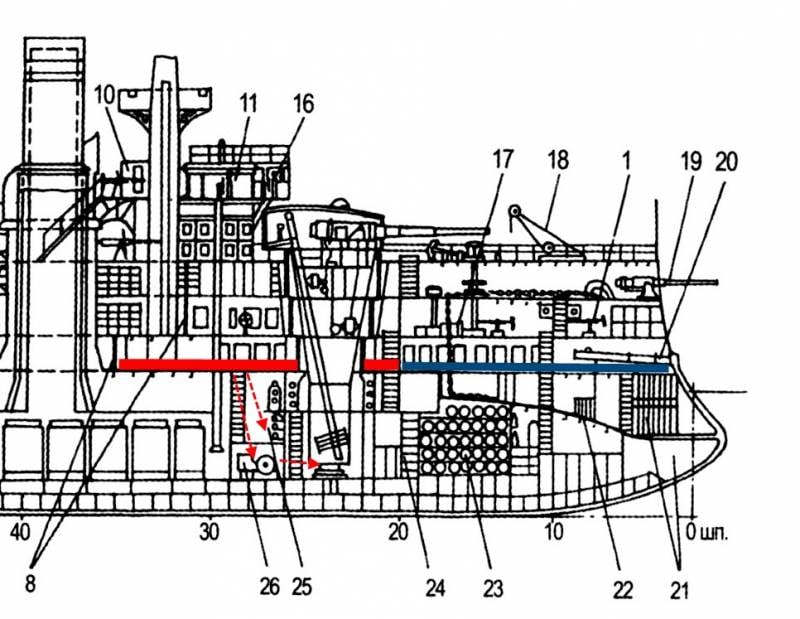
The diagram shows: blue - water penetration into "Peresvet" and "Oslyabya", red - into "Oslyabya", dotted arrows indicate the compartments into which water in "Oslyabya" passed, according to V. Zavarin
Unfortunately, there is a nuance here: alas, the author is not at all sure that he was able to correctly determine the location of the 1st bulkhead on the living deck.
The second hit to the "Peresvet", judging by the description, had, though in the unarmored side, but above the main armor belt. The fact is that, according to eyewitnesses, the office was destroyed by the explosion of this shell. Only now there was no office on the living deck of "Peresvet", but there were as many as 2 offices on the starboard side on the battery deck. They were located behind the barbette of the bow tower, but up to the traverse, which makes it possible to determine the place of the second hit.
It is interesting that the presented scheme does not fully correspond to the drawings of the damage to the "Peresvet" made by eyewitnesses. However, it does not correspond too much to the descriptions of eyewitnesses. So, for example, in the area of the first hit of the Japanese shell, we see not one large hole, but two. Could two such holes have been produced by a single shell hit? At the same time, the second hit, which destroyed one of the offices, is depicted as something completely indistinct. There are other inconsistencies in this figure, but we will not analyze them in detail.
In any case, it is reliably known that from the second hit in the nose, the "Peresvet" suffered much more inconvenience than from the first. The water spread along the living deck from the armored beam and up to ... according to Cherkasov, to the "third bulkhead ahead of the bow beam." Alas, from the drawings provided by V. Krestyaninov and S. Molodtsov, it is in no way possible to make out where she was. But, apparently, it was located towards the nose of the main caliber turret. The fact is that, according to testimonies, the only way out of the turret compartment of the nasal 254-mm tower of "Peresvet" was the supply pipes, since there was water in the compartments above it. And this water could get there only by spilling over the living deck, and since the flow of water from the 1st hit was restrained by the bow bulkhead, then there are no other options.
Consequently, the Japanese 305-mm projectile, which destroyed the office, still led to flooding below the level of the living deck. The water went into the bomb and cartridge magazines (but it is unclear what weapons, probably, we are talking about the 152-mm cannons in the bow casemates), the turret compartment, the submarine TA and dynamo compartments. That is, the distribution of water in this case is very similar to that received by "Oslyabya": everything was drowned on it.
Only "Oslyabe" all these floods took on an uncontrollable character: despite attempts to stop the flow of water into the hull, she continued to arrive through the ventilation pipes. And on "Peresvet", although the dynamos were flooded so that people had to be taken out of there, the further spread of water was completely limited by battening down the waterproof hatches.
This fact raises many questions. It turns out that the watertight hatches below the waterline were not battened down on the Peresvet in the battle? This is, generally speaking, sloppiness, but it is beyond the scope of this article. According to the descriptions of eyewitnesses, the situation was like this: the hatch in the armored deck, which is also the exit from the TA compartment to the living deck, was opened, as, incidentally, happened on the Oslyab. Through this hatch, water flowed to the torpedo tubes and below, to the dynamo compartment, and from there - to the turret compartment of the bow 254-mm turret. But as soon as the hatches on the armored deck and in the turret compartment were closed, then the water flow into the compartments below the living deck (marked in the diagram above with dotted arrows) completely stopped. Ventilation pipes "Peresvet" did not "leak", accordingly, the compartments of the ship in the bow remained tight.
The author does not know the design of the ventilation system on ships of the "Peresvet" class. But common sense dictates that such a system poses a known danger to the survivability of the ship and that it is necessary to be able to prevent the spread of water through it. It was on Peresvet, but for some reason it did not work on Oslyab: it should be assumed that the quality of the ship's construction is to blame here.
Thus, the damage to Peresvet, caused by two 305-mm Japanese shells hitting the bow of the ship, was limited to flooding of the living deck from the stem to the armored traverse, and a relatively small amount of water that entered the dynamo compartment. It is also possible that water nevertheless penetrated into some spaces located between the living and armored deck. But in the reports there is not a single mention of flooding below the armored deck, except for the unfortunate section of dynamos.
The damage to the "Peresvet" and "Oslyabi" is similar in that there were holes at the level of their residential decks that could not be repaired. That is, the sea had completely free access to the living decks of both of these ships. But "Peresvet" did not have a trim on the nose, while "Oslyabya" received this trim.
Why?
Let's go, as they say, from the opposite.
The masses of water spilling over the living deck, by themselves, could not have caused a bow trim. The living deck was located in height at the level of the upper edge of the armor belt, in other words, even when the ship was overloaded, in which the belt completely went under the water, this deck turned out to be only centimeters below sea level. Of course, taking into account even a weak excitement, the forward movement of the ship, during which it seems to "capture" water into itself through a hole in the bow, a certain amount of water will certainly flow, even if the deck remains above sea level. What is interesting: and M.P. Sablin, and V.N. Cherkasov pointed out that the water on the residential decks of the battleships was about 60 cm (two feet), only M.P. Sablin said that the water subsequently arrived, and V.N. Cherkasov did not report anything of the kind.
But what is this 60 cm? On the scale of the ship - minuscule. Even if such a layer of water covered the entire living deck, with all the rooms on it and up to the fore armored beam, excluding only the flooding of the coal pits and the 254-mm tower feed pipe, then in this case the total water mass hardly exceeded 200 tons , and even distributed from the stem and almost to the 1st pipe. Such a load, of course, could not cause a significant trim on the nose. And in the case of "Peresvet" she did not call him.
But, perhaps, "Oslyabya" took more water onto the living deck due to the fact that it was overloaded more than "Peresvet"? Consider this version. The construction overload of "Peresvet" was 1 tons, "Oslyabi" - 136 tons. Accordingly, "Oslyabya" was roughly 1 tons heavier. Coal reserves at "Oslyab" in the morning of May 734, according to the data of the cruiser "Almaz", were 600 tons. Consumption per day on ships of the "Peresvet" type was 13-1 tons, and at Oslyabi "on the last passages - about 415 tons, so by the beginning of the battle the amount of coal on the ship was probably somewhere between 100 and 114 t. As for the "Peresvet", then, according to the testimony of the Investigative Commission of the inspector Lieutenant Tyrtov 100nd, the battleship went out to sea, having about 1250 tons of coal and by the beginning of the 1nd phase of the battle it was apparently even more than on "Oslyab". As for the rest of the scales, then, alas, nothing can be said for sure. It is possible, of course, that "Oslyabya" had some excess water reserves and so on. But there is no information about this, but it is known that some excess weights were on the "Peresvet" in the battle at Shantung. The same Tyrtov 300nd pointed out that "there was a three-month supply of provisions on the battleship."
Thus, it can be assumed that the difference in the weights of the "Peresvet" and "Oslyabi" in the battle at Shantung and in the Battle of Tsushima was no more than 500-600 tons. And taking into account the fact that the cargo of this type of ships increased by 20,55 tons. draft by 1 cm, the difference in draft between Peresvet and Oslyabi was 25-30 cm. That is, if the living deck was completely flooded under the conditions described above, Oslyabya would receive about 100 tons of water more than Peresvet, but rather everything, even less.
It turns out that the additional mass of water that could enter the Oslyabya due to the fact that this battleship sat in the water deeper than the Peresvet is measured in tens, well, maybe hundreds of tons. Such a difference, of course, could not at all become the reason for the appearance of a strong trim in the Oslyabi, if the Peresvet did not have it. So the overload version disappears.
Could any additional damage to the Oslyabi hull from Japanese 152-203 mm shells have led to an increase in the amount of water on the upper deck? No, they couldn't. No matter how many such shells hit the Oslyabi hull in the waterline area, all they could do was to open the way for water to the living deck. Well, after all, it was already open - through a hole from a 305-mm projectile.
Could it be that the Oslyabi's bow was trimmed as a result of another hit by a 305-mm projectile in the bow of the ship, which was observed from Fuji? The commander of "Navarin" Ozerov assumed that the battleship received a blow of such force that it had already lost its armor plates:
As can be seen from the quote, Ozerov himself did not see any fallen armor plates. He only assumed that this had happened, seeing the plight of the Oslyabi. In other words, we do not know whether this hit was or not, we do not know whether it caused the destruction or even falling off of the armor plate or did not. But we know for sure ... that Peresvet received a similar hit.
At about 16:45, a 305-mm Japanese shell hit the 229-mm armor belt along the waterline, in the area of the 39th frame under the bow casemate. The shell did not pierce the armor, but gave a protracted rupture, as a result of which it managed to break off part of the armor plate (a triangle 1 m high and 0,8 m base point downwards). As a result, the battleship received flooding of 2 upper coal pits (20 tons of water each) and two lower ones (60 tons each), and a total of 160 tons of water entered the battleship's hull. At the same time, the bevels of the armored deck did not suffer: the water flowed down through the loosely closed necks. And this flooding, again, did not cause any trim, but only a roll, which was easily eliminated by counter-flooding of the compartments on the left side.
Accordingly, even if another 305-mm projectile from "Fuji" nevertheless hit the nose of the "Oslyabi" and damaged the armor belt (and on "Peresvet" this happened only thanks to an untimely detonated fuse), this should not have become the reason for the trim on the bow, which this battleship received in the Battle of Tsushima - after all, a similar hit to the "Peresvet" did not lead to anything like that.
Thus, the only reasonable explanation for the appearance of a trim on the bow is the gradual flooding of the bow compartments of the Oslyabi located below the waterline. It is likely that it spread most intensively through the ventilation pipes, but it is possible that there were other leaks - through the living or armored deck that was loosened from the explosion of an enemy shell, and simply through cracks, leaking joints of steel sheets.
On criticism of the version of flooding of the bow compartments
In the discussion of the previous material, the idea was expressed that such flooding of the Oslyabi could not cause a strong trim, since the volume of the bow compartments is too small to take in a sufficient amount of water. In order to understand how justified this opinion is, let's recall the very beginning of the Russo-Japanese War, namely, a torpedo hit on the battleship Retvizan. Which, by the way, in terms of normal displacement was even less than the Oslyabi.
The Japanese "self-propelled mine" hit ... just as deliberately, in about the same place as the Japanese 305-mm shell in "Oslyabyu". "Retvizan" was struck in the left bow of the hull, in the room of underwater mine vehicles (they were located in front of the barbette of the bow tower of the main caliber, and not behind). Of course, the extent of the damage was incomparable: the torpedo made a hole with an area of 160 square meters. feet, that is, about 15 sq. m, twelve-inch shells, even high-explosive, were not capable of this. But what happened next? Official historiography reports:
But why was the Retvizan commander so sure that he could enter the internal raid? Here is a snippet of his report:
That is, the battleship commander believed that the flooding of only one compartment of his ship could give a trim of up to 1,5 m. However, according to the report of E. N. Shchensnovich to the head of the Pacific squadron, this preliminary assessment of his turned out to be overly optimistic: in fact, “ Retvizan "were flooded not 1, but 3 compartments" with a capacity of about 500, 700 and 1000 tons. " That is, in total, the battleship took 2200 tons of water into the bow compartments. But where did E. N. Shchensnovich miscalculate, counting on the flooding of only one compartment? Official Russian historiography reads:
Thus, we can say that the problems of "Oslyabi" and "Retvizan" turned out to be extremely similar. Both ships received holes in the bow on the port side. On both battleships, there was an uncontrolled flow of water into the intact compartments through the ventilation system. Russian official historiography notes that at the Retvizan, water was also supplied through "mines and elevators, which were brought only to the residential deck on the Retvizan, and not higher", but it should be understood that there could have been others on the Oslyab. leaks ", except for ventilation. As a result, "Retvizan" ran aground, taking 2 tons of water into the bow compartments. The photo clearly shows that the bow of the ship sank to the level of the upper deck.
Noteworthy is the difference in the time of flooding. The fact is that the Retvizan ran aground with its nose a little less than 2 hours after being blown up by a mine, and Oslyabya went into the water “right up to the hawks” in just 25 minutes, counting from the moment the 305-mm projectile hit into its nasal end. But here, most likely, this was the case.
While the Retvizan remained at anchor, it was possible to set sail on its hole, which significantly limited the flow of water into the ship. Probably, that is why E. N. Shchensnovich, seeing that the trim was not too great, planned to go to the inner roadstead. If his battleship immediately sat down in the water on the upper deck, such an idea, of course, could not arise. But when the "Retvizan" set in motion, the flow of water through the fragile barrier intensified, and the trim on the bow began to grow rapidly, which led the battleship aground. In other words, it should be assumed that the mine explosion quickly flooded the premises located in the area of the damaged side, but the further inflow of water was stopped by the wound sail: but it increased significantly when the battleship started moving.
Well, the Oslyabya was not at anchor at all, but was sailing on a rather fresh sea, despite the fact that its hole was not closed at all by anything. In addition, it is necessary to take into account that the Retvizan was divided into 15 watertight compartments, and the Oslyabya - only 10. The bow of the Oslyabi up to the boiler rooms was divided into 3 such compartments: the ram, the bow ammunition magazines and the turret bow, while the Retvizan had six watertight compartments in the nose, which could also affect the rate of flooding. And, of course, the Oslyabya did not land with its bow as much as the Retvizan - not to the level of the upper deck, but only to the haws, which corresponded to a trim within 3 m, perhaps a little more.
About getting into the area of the 10th coal pit
It remains to consider getting into the area of the 10th coal pit "Oslyabi". MP Sablin believed that this hit had broken through the armor. But was there? And if so, which one? A Japanese shell could break off a piece of armor by analogy with how it happened with the "Peresvet". He could simply loosen the 229-mm armor plate and thus cause water to flow into the Oslyabi hull. It is also possible that in fact the Japanese shell hit not the 229-mm, but the 102-mm plate and pierced / loosened / split it. The example of "Peresvet" shows that if such a hit on the "Oslyabya" occurred directly above the edge of the 229-mm armor plate, then the hole was "perfectly" filled with water.
It should be assumed that some gigantic hole did not happen there, especially since the surviving members of the Oslyabya crew speak only of the flooding of the 10th pit and the secondary pit-chamber located under it. It is unlikely that more water could have flowed into it than Peresvet received with its 2 lower and 2 submerged upper coal pits flooded. But attention is drawn to the fact that the counter-flooding on "Peresvet" quickly removed the roll to starboard, while on "Oslyab" for some reason it did not lead to success at all.
Other hits in "Peresvet"
Of these, only 3 hits are worthy of mention. Two shells of 152-254 mm caliber (more precisely, alas, it was not possible to determine) landed in a 178-mm armor belt below the waterline. The armor plates withstood the blow with honor: although the wooden and copper sheathing in the area of the hits was destroyed, and the shirt, five frames and the bulkhead behind the armor were bent, water did not enter the hull. Another projectile of unknown caliber hit Peresvet at the waterline under the 75-mm gun # 17, that is, in the area of the middle chimney, and also did not cause any noticeable harm.
Other hits in the hull, casemates, deckhouses and other parts of the ship could not have a significant effect on its unsinkability, as, incidentally, and similar hits in "Oslyabya", and therefore will not be considered by the author in this article. But there is one nuance that I would like to draw the attention of dear readers.
37 enemy shells hit "Peresvet", 35 of them - in the battle of the main forces. Only 6 of them hit the waterline area, including 4 in the armored belt. And only one large-caliber projectile, hitting the armor belt, managed to cause damage (flooding of coal pits).
These statistics should always be taken into account by those who believe that Oslyabya received a lot of damage in the waterline area with 152-203 mm ammunition. Even if Oslyabya was bombarded with enemy shells, even if (a very fantastic assumption) it received one and a half times more hits than Peresvet, this still statistically gives up to 9 hits in the waterline area, taking into account the hits of 305-mm shells with " Fuji ", of which up to two-thirds still had to be in the armored belt. And medium-caliber shells could not overpower the Oslyabi armor. And therefore it is extremely doubtful that the "hail of six- and eight-inch shells" will cause any noticeable damage to the ship's buoyancy.
Important factor
V.N. Cherkasov:
It must be said that the bank at Peresvet appeared even earlier: Lieutenant Tyrtov II noted that "a significant bank that prevented the correct aiming" appeared already during the battle of the main forces.
Conclusions
According to the author's hypothesis, neither "Peresvet" nor "Oslyabya" suffered any damage, in which a well-built ship of this project had to sink. But the Baltiysky Zavod, which built Peresvet, managed to provide its brainchild with a quite decent quality of construction, as a result of which its protection, built according to the “English principle,” worked normally. Damage to the unarmored parts of the hull did not lead to flooding of the bow compartments located below the armored (rather, even below the residential) deck. The relatively small amount of water taken by the ship on the living deck did not cause a bow trim. And when the next enemy projectile damaged the armor belt, causing water to flow into the coal pits and the ship's roll, this roll was quickly parried by counter-flooding. Only later, when the ship to a certain extent used up part of the coal and ammunition, the list appeared again, but it did not threaten the ship with destruction.
"Oslyabya" is another matter. This ship was built at the shipyard of the New Admiralty, which at that time was inferior to the Baltic shipyard in all respects. The difference in construction overload has already been mentioned: "Oslyabya" turned out to be about 600 tons heavier. At the same time, while the "specialists" of the New Admiralty were building one ship ("Oslyabya"), the Baltic Shipyard actually built two: "Peresvet" and "Pobeda". There were also many complaints about the quality of the materials from which the "Oslyabya" was made, and the quality of the work itself ... The nasal compartments of the "Peresvet", located below the waterline, retained tightness, but the "Oslyabya" in the turret compartment and the compartments located behind it water was supplied through the ventilation.
All these are facts confirmed by sources, and then hypotheses follow. As mentioned earlier, the author assumes that water also penetrated into the other nasal compartments of the Oslyabi through all the same faulty ventilation, gradually flooding them. This caused the appearance of a bow trim, as a result of which the living deck gradually went lower and lower relative to sea level, and the mass of water on it increased. By the way, the increase in the mass of water on the living deck of the "Oslyabi" was noted by MP Sablin.
The result is a synergistic effect. The more the bow compartments were drowned, the more the trim increased and the more water entered the living deck. And the more water entered the living deck, the faster it flows through the ventilation system, cracks in the deck, etc. heated the bilge compartments. As a result, the trim on the bow quickly increased, and significantly more water entered the living deck of the Oslyabi than the Peresvet received.
When the second Japanese projectile caused flooding in the area of the 10th coal pit, the Oslyabya was banked to the port side and exactly what VN Cherkasov described happened: the masses of water on the living deck overflowed to the left side and thereby significantly increased the roll ... That is, the flooding of the 10th coal pit and the spare pit-chamber played the role of "turning the rudder" of "Peresvet" as presented by VN Cherkasov.
The "Peresvet" on the living deck did not have so much water, and when "overflowing" it gave a roll of 7-8 degrees. But the "Oslyabi" had much more water on the living deck, which contributed to the increase in the roll up to 12 degrees by the time the ship was out of order of the squadron. The counterflooding could not help the Oslyaba, most likely because only the water that entered the 10th coal pit was taken into account, and the masses of overflowing water on the living deck were not taken into account. Or there were, but they simply did not have time to organize counterflooding of the corresponding scale.
In fact, only one question arises: the scale of the Oslyabi ventilation malfunctions. If it was impossible to restrict the spread of water through the compartments, then it should be considered that a single hit of a 305-mm projectile in the bow of the ship was a mortal wound for him. In this case, even if no more shells had hit the Oslyabya, the battleship would still be doomed. As in the case of the Retvizan, the water would gradually spread through the bow compartments of the battleship, and the Oslyabya sank with a large trim on the bow. This version looks the most realistic, also because the mine-machine conductor V. Zavarin did not find an opportunity to stop the flooding of the compartments through the ventilation, although he was clearly striving for this.
If, nevertheless, the spread of water could be stopped (which is doubtful), then the damaged artillery ports on the left side of the Oslyabi became the verdict for the ship. As mentioned in the previous article, after the Oslyabya landed with its bow on the haws, the port side gun ports were near the water, and, since the weather was fresh, they began to flood. Attempts to repair them were unsuccessful, water spread over the battery deck, which doomed the ship to death. But in both cases, the root cause of the death of the squadron battleship Oslyabya, according to the author, should be considered a malfunction in the ventilation system and, possibly, other flaws in the structure, due to which its nasal compartments lost their tightness and were flooded with water.
It is interesting that in the battle of July 28 at Shantung at the "Peresvet" gun ports also fell into disrepair. But due to the absence of any noticeable trim and the fact that the list of the ship did not exceed 7-8 degrees, this did not threaten the ship at all.
A bit of an alternative
Let us imagine for a moment that in the ranks of Russian ships in the Battle of Tsushima, instead of the Oslyabi, it was Peresvet. What would happen in this case? Never mind! Having received a hole in the unarmored port side, the ship would have received a small amount of water on the living deck. And, since this water turned out to be relatively small, then getting into the area of the 10th boiler pit would only lead to a short-term roll, which would soon be parried by counterflooding. In place of "Oslyabi" "Peresvet" not only would not have died, he would not even be out of order and would have continued to fight.
But what happened to the "Oslyaby", if he was in battle in the Yellow Sea? Yes, exactly the same as in the Tsushima battle. Having received three 305-mm projectiles at the waterline, the ship would also lose the tightness of the bow compartments and would land with its bow on the hawses. If we assume that the spread of water could still be limited, then, perhaps, he would have held out a little longer than was released to him in the Battle of Tsushima, due to the timely straightening of the bank from flooding in coal pits. But even then "Oslyabya" would still sooner or later get a roll to the left or right side, and even if the rudder was turned by analogy with the "Peresvet", after which its gun ports would be flooded with water and it would overturn. Well, if the author is right in the assumption that the spread of water through ventilation pipes and other "leaks" has become irreversible, then even the timely straightening of the roll would give the ship at most another 40-50 minutes of life, after which it would go to the bottom without any roll ...
Thus, according to the author, if suddenly, by a wave of a magic wand, a miracle happened, and "Peresvet" and "Oslyabya" changed places in their battles, then "Peresvet" would definitely survive the first hour of the battle of the main forces, and if died in the future, then only as a result of other hits, which "Oslyaba" no longer needed. But for "Oslyabi" the battle at Shantung would have become a death sentence, although, perhaps, not carried out as quickly as it happened in Tsushima.
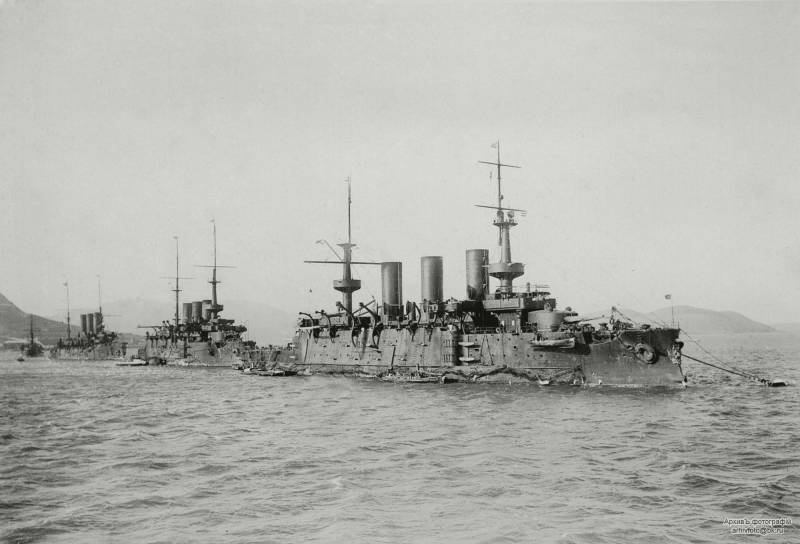
"Peresvet" and "Victory". These ships could well have survived the fire of Japanese ships at the beginning of the Tsushima battle.
Some consequences
I have a good idea of what they will write about this in the comments, but ... Taking this opportunity, let's consider the legality of a couple of accusations against the commander of the 2nd Pacific squadron ZP Rozhestvensky, which have long become classics.
It is often argued that the reason for the death of the "Oslyabi" was the overload of the ship, which caused its armor belt to go under water. But in order to reduce the draft of "Oslyabi" to the level of "Peresvet", he should have reduced the supply of coal much lower than normal, to about 700 tons. And this was a crime: suffice it to recall that the coal pits of "Peresvet" when he returned from the battle at Shantung in Port Arthur, were almost empty, although he went into battle with 1 tons of coal. Obviously, "Oslyabya" with 500 tons of coal did not have a single chance to reach Vladivostok.
But suppose that ZP Rozhestvensky still ordered the Oslyabya to be unloaded in such a way as to achieve precipitation at the Peresvet level. What would he achieve with this? Let us recall that the shell that destroyed the office of Peresvet exploded over the main armor belt, and as a result of this the seemingly not overloaded ship received a massive flooding along the residential deck. That is, you need to understand that even the draft of "Peresvet" on July 28, 1904 did not guarantee the elevation of the main armor belt enough to prevent flooding through the holes received above the armor plates, even in the relatively calm sea of the battle at Shantung. In the Tsushima battle, the excitement was more serious, and in order to have at least a shadow of hope that the holes on top of the Oslyabi's armor belt would not be overwhelmed by water, it was necessary to completely unload all coal supplies and lead the battleship into battle in tow ...
And further. The author never claimed that ZP Rozhdestvensky had ideally rebuilt his squadron before the battle of the main forces in Tsushima. Without a doubt, the Russian commander was mistaken, he calculated the maneuver incorrectly, as a result of which the Oryol did not have time to take a place in the ranks. This mistake was aggravated by the "inaction" of the commander of the Oslyabi Baer, who, instead of somehow reacting to the mistake of his admiral (to reduce speed, to make a left coordinate, etc.), simply walked forward until, in order to avoid a collision, had to slow down sharply, literally stopping the battleship. But in any case, it was ZP Rozhestvensky who created the prerequisites for the "clustering" of the Eagle and the lead ships of the 2nd armored detachment.
However, contrary to popular belief, this mistake did not cause the death of Oslyabi. If in place of "Oslyabi" by some miracle there were "Peresvet" or "Victory", then no tragedy with capsizing and sinking of the ship at 14.40:14 on May 1905, XNUMX would not have happened. The damage that "Oslyabya" received in the first half hour of the battle should not have led to the death of a ship of this type (subject to high-quality construction, of course).
And the last thing. When today they are discussing how to outplay Tsushima by separating squadron battleships of the Borodino and Oslyabyu type into a separate detachment, one must understand that the latter was a very conventional combat unit. According to the author's hypothesis, for a completely untimely death, Oslyaba needed only one (!) Successful hit of a 305-mm Japanese shell at the ship's waterline into the unarmored bow part of the hull. Thanks to the bunglers of the New Admiralty.
And you, dear readers, thank you for your attention!
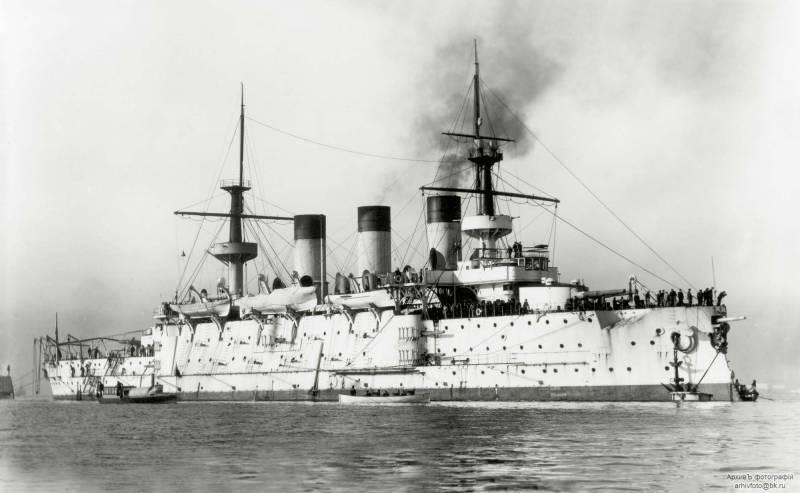
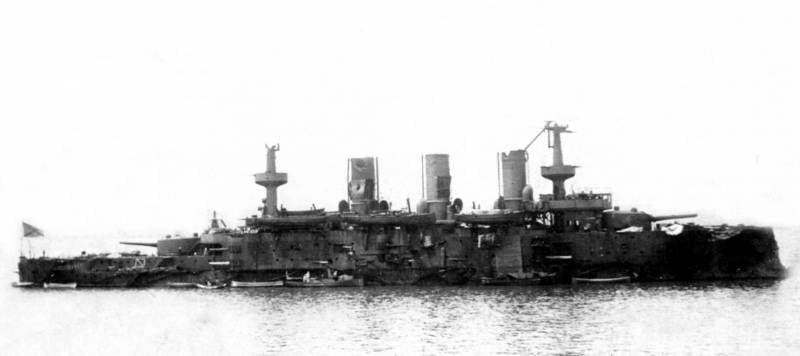
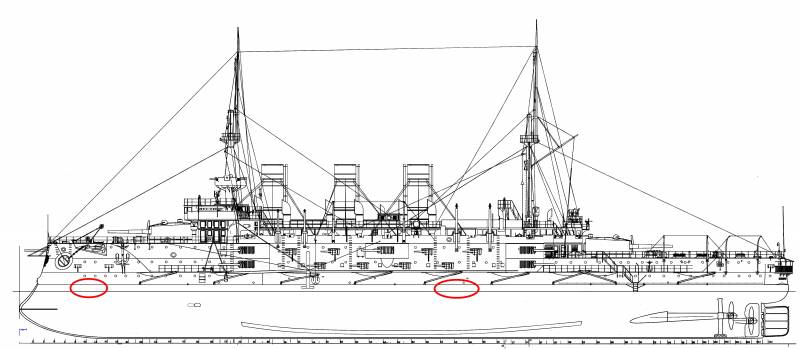
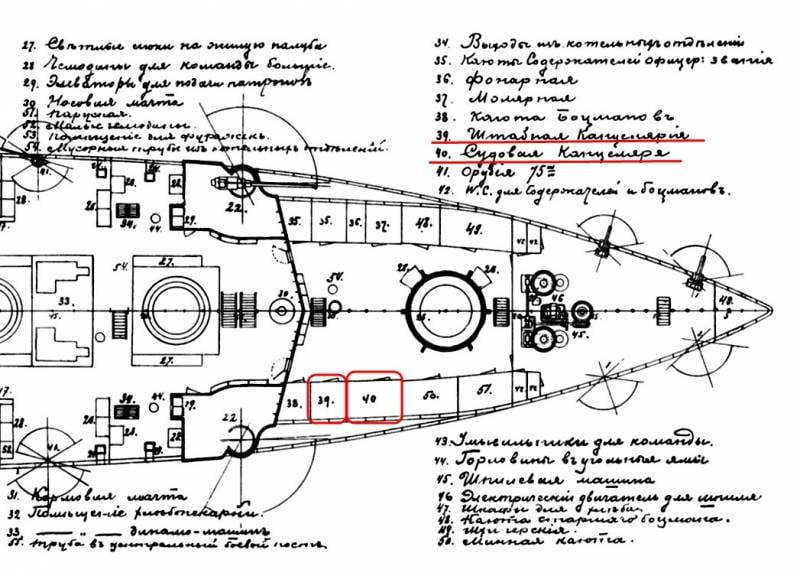

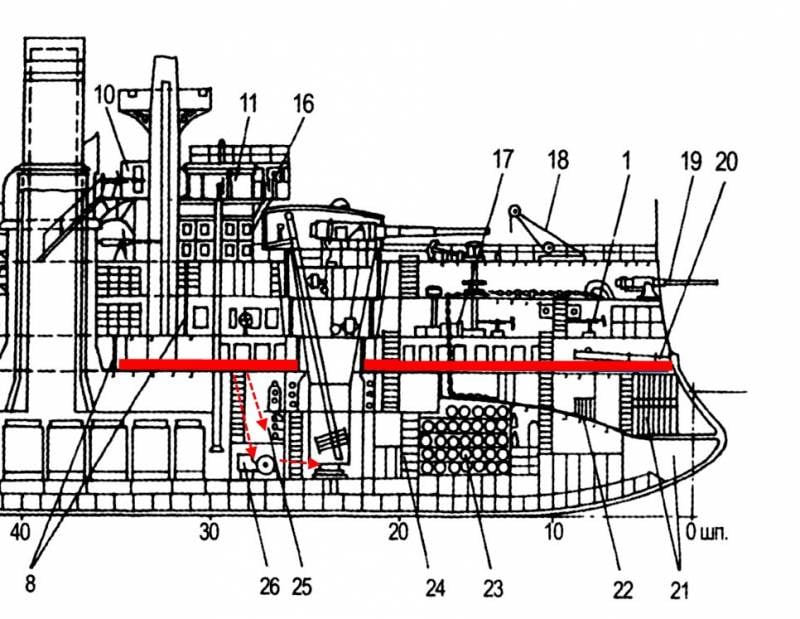

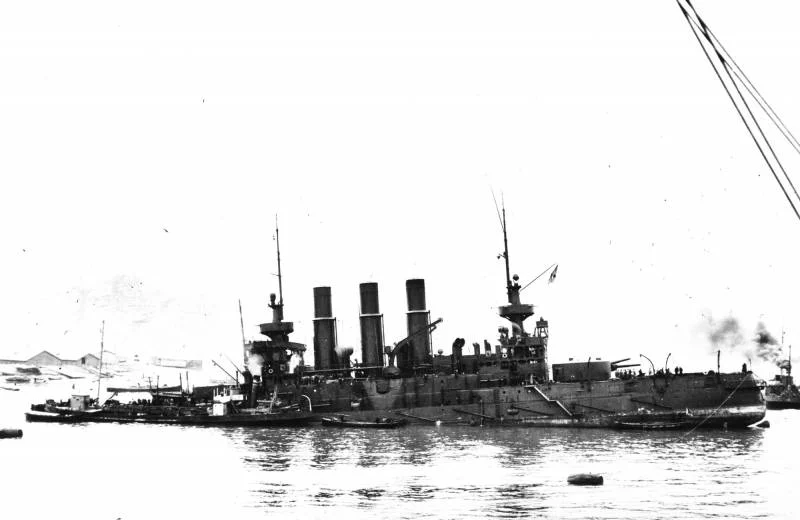
Information